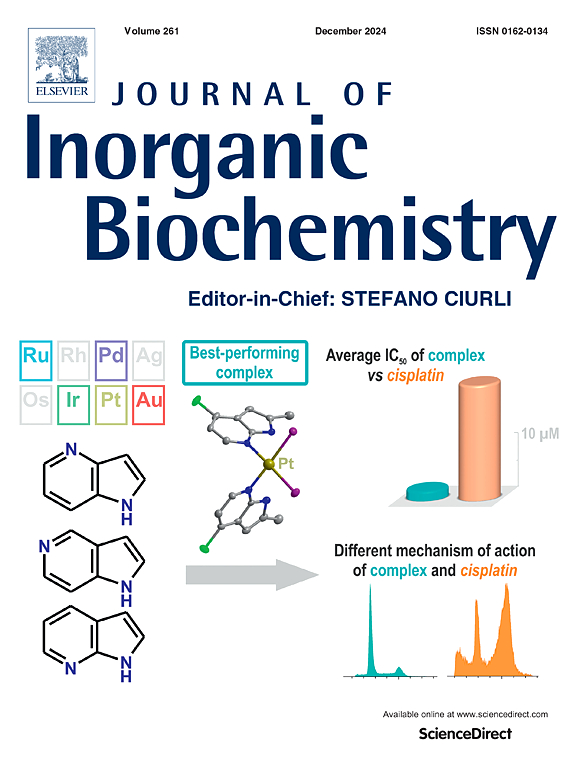镉(II)配合物与吡啶/二羧酸配体作为治疗口腔念珠菌病的有前途的分子
IF 3.2
2区 化学
Q2 BIOCHEMISTRY & MOLECULAR BIOLOGY
引用次数: 0
摘要
念珠菌的过度生长,以其对生物和非生物表面的强附着力而闻名,使假牙口炎的治疗变得困难。为了解决这一挑战,合成了两种含有2,5-吡啶二羧酸(H2L)的新型镉(II)配合物(配合物1 [Cd(HL)(H2O)(DMSO)I]2和[Cd(HL)(H2O)(bipy)I]配合物2),并通过x射线衍射、HRMS-ESI(+)光谱法、1H和13C NMR、FT-IR和元素分析对其进行了全面表征。这些复合物的抗真菌、抗生物膜、溶血和致突变性被评价。这些复合物与已建立的抗真菌药物的相互作用也进行了研究。两种配合物的MIC值为62.5 (97.91 μM) ~ 0.48 (0.75 μM) μg/mL, MFC值为125 (195.82 μM) ~ 3.80 (5.95 μM) μg/mL。此外,这些配合物有效地抑制了假体丙烯酸树脂试样上克氏弧菌生物膜的形成,其中配合物2的活性更强。配合物与氟康唑也有协同作用,山梨醇实验表明,细胞壁是配合物的靶点之一。重要的是,溶血实验表明这些复合物对人红细胞没有细胞毒性,致突变性实验证实了它们的非致突变性。这些结果表明,合成的镉(II)配合物,特别是配合物2,在治疗假牙口炎和口腔念珠菌病方面具有很大的潜力。本文章由计算机程序翻译,如有差异,请以英文原文为准。

Cadmium(II) complexes with pyridine/dicarboxylic acid ligands as promising molecules for the treatment of oral candidiasis
Overgrowth of Candida spp., known for its strong adhesion to biotic and abiotic surfaces, makes treatment difficult in denture stomatitis. To address this challenge, two novel cadmium(II) complexes containing 2,5-pyridinedicarboxylic acid (H2L) (complex 1 [Cd(HL)(H2O)(DMSO)I]2 and [Cd(HL)(H2O)(bipy)I] complex 2), were synthesized and fully characterized by X-ray diffractometry, HRMS-ESI (+) spectrometry, 1H and 13C NMR, FT-IR and elemental analysis. These complexes were evaluated for their antifungal, antibiofilm, hemolytic, and mutagenic properties. The interaction of these complexes with established antifungal agents was also investigated. Both complexes demonstrated remarkable antifungal activity, particularly against C. albicans and C. krusei, with MIC ranging from 62.5 (97.91 μM) to 0.48 (0.75 μM) μg/mL and MFC from 125 (195.82 μM) to 3.80 (5.95 μM) μg/mL. Furthermore, these complexes effectively inhibited C. krusei biofilm formation on prosthetic acrylic resin test specimens, with complex 2 showing superior activity. The complexes also displayed synergistic effects with fluconazole, furthermore, sorbitol assays have shown that cell wall is one of the targets of the tested complexes. Importantly, hemolysis assays indicated that the complexes were non-cytotoxic to human erythrocytes, and mutagenicity assays confirmed their non-mutagenic nature. These findings suggest that the synthesized cadmium(II) complexes, particularly complex 2, possess significant potential as therapeutic agents for the treatment of denture stomatitis and oral candidiasis in general.
求助全文
通过发布文献求助,成功后即可免费获取论文全文。
去求助
来源期刊

Journal of Inorganic Biochemistry
生物-生化与分子生物学
CiteScore
7.00
自引率
10.30%
发文量
336
审稿时长
41 days
期刊介绍:
The Journal of Inorganic Biochemistry is an established international forum for research in all aspects of Biological Inorganic Chemistry. Original papers of a high scientific level are published in the form of Articles (full length papers), Short Communications, Focused Reviews and Bioinorganic Methods. Topics include: the chemistry, structure and function of metalloenzymes; the interaction of inorganic ions and molecules with proteins and nucleic acids; the synthesis and properties of coordination complexes of biological interest including both structural and functional model systems; the function of metal- containing systems in the regulation of gene expression; the role of metals in medicine; the application of spectroscopic methods to determine the structure of metallobiomolecules; the preparation and characterization of metal-based biomaterials; and related systems. The emphasis of the Journal is on the structure and mechanism of action of metallobiomolecules.
 求助内容:
求助内容: 应助结果提醒方式:
应助结果提醒方式:


